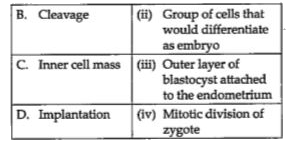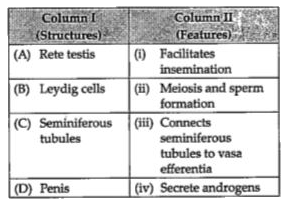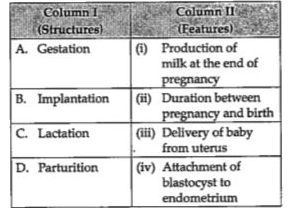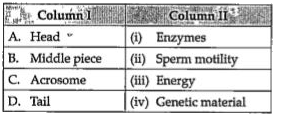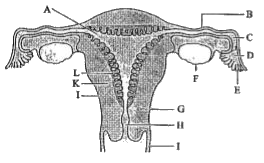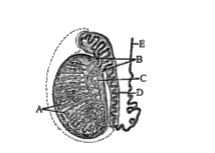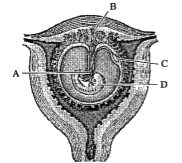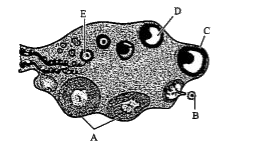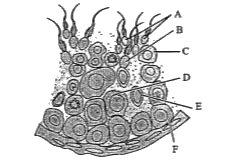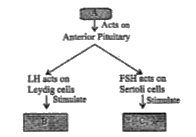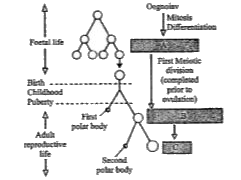MATCH THE FOLLOWING from SRIJAN BIOLOGY (ENGLISH) HUMAN REPRODUCTION for Class 12
| Class 12 | BIOLOGY |
| Chapter | HUMAN REPRODUCTION |
| SRIJAN BIOLOGY (ENGLISH) | MATCH THE FOLLOWING |
| Medium | English |
| Academic Year | 2023-2024 |
Question 46
Each seminiferous tubule is lined on its inside by two types of cells called .........A........and.........B................... The seminiferous tubules open into ..............C.......... .. through .............. D.................. The enlarged end of penis called .......... E ................... is covered by a loose fold of skin called .......... F.............. View SolutionQuestion 47
During fertilisation, a sperm comes in contact with the zona pellucida layer of the ovum and induces changes in the membrane that block the entry of ...................A ............... The secretions of the ........... B................... help the sperm enter into the cytoplasm of the ovum. View SolutionQuestion 51
Identify A, B, C, and D in the given statement and select the correct option "During ................A................... phase of the menstrual cycle, if pregnancy does not happen, the .........B .............. Withers and dies, usually around day 22 in a 28-day cycle. The drop in ................C................... levels causes the lining of the uterus to fall away. This is known as............D............... View SolutionQuestion 60
Match the functions given below with the associated part or parts of the human male reproductive system labelled from A to G in the figure given below.
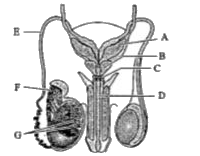
(i) Produces sperm
(ii) Connects the epididymis with the urethra
(iii) Produces secretion that lubricates the penis
(iv) Conducts sperms through the penis to the outside of the body .View SolutionQuestion 74
Adolescence is the period of dramatic physical and psychological changes in a person. An adolescent person is at high risk of falling in the trap of drug or alcohol abuse. Common causes are, curiosity, excitement, experimentation, etc. Drugs are frequently used because of their perceived benefits. The inherent addictive nature of these substances results in addiction and dependence. Addiction is a psychological attachment to various effects of a substance. So, a person continues to take addictive substance even when he does not need it in the real sense. Tolerance level of the receptors ion our body increases with repeated use of addictive substances. This results in body craving for higher doses. Long term consequences of addiction can be highly devastating. Parents and teachers should take responsibility to identify situations which may trigger unwanted behaviour. Parents and teachers should instil self discipline adolescent persons. Peer pressure should be avoided at all cost. Proper steps should be taken to increase awareness. If the need arises, then professional help should also be taken.
Nicotine acts as a stimulant because it mimics the effect of: View SolutionQuestion 75
Adolescence is the period of dramatic physical and psychological changes in a person. An adolescent person is at high risk of falling in the trap of drug or alcohol abuse. Common causes are, curiosity, excitement, experimentation, etc. Drugs are frequently used because of their perceived benefits. The inherent addictive nature of these substances results in addiction and dependence. Addiction is a psychological attachment to various effects of a substance. So, a person continues to take addictive substance even when he does not need it in the real sense. Tolerance level of the receptors ion our body increases with repeated use of addictive substances. This results in body craving for higher doses. Long term consequences of addiction can be highly devastating. Parents and teachers should take responsibility to identify situations which may trigger unwanted behaviour. Parents and teachers should instil self discipline adolescent persons. Peer pressure should be avoided at all cost. Proper steps should be taken to increase awareness. If the need arises, then professional help should also be taken.
Continuous use of alcohol causes:View SolutionQuestion 76
Adolescence is the period of dramatic physical and psychological changes in a person. An adolescent person is at high risk of falling in the trap of drug or alcohol abuse. Common causes are, curiosity, excitement, experimentation, etc. Drugs are frequently used because of their perceived benefits. The inherent addictive nature of these substances results in addiction and dependence. Addiction is a psychological attachment to various effects of a substance. So, a person continues to take addictive substance even when he does not need it in the real sense. Tolerance level of the receptors ion our body increases with repeated use of addictive substances. This results in body craving for higher doses. Long term consequences of addiction can be highly devastating. Parents and teachers should take responsibility to identify situations which may trigger unwanted behaviour. Parents and teachers should instil self discipline adolescent persons. Peer pressure should be avoided at all cost. Proper steps should be taken to increase awareness. If the need arises, then professional help should also be taken.
Tobacco inhalation causes: View SolutionQuestion 77
Adolescence is the period of dramatic physical and psychological changes in a person. An adolescent person is at high risk of falling in the trap of drug or alcohol abuse. Common causes are, curiosity, excitement, experimentation, etc. Drugs are frequently used because of their perceived benefits. The inherent addictive nature of these substances results in addiction and dependence. Addiction is a psychological attachment to various effects of a substance. So, a person continues to take addictive substance even when he does not need it in the real sense. Tolerance level of the receptors ion our body increases with repeated use of addictive substances. This results in body craving for higher doses. Long term consequences of addiction can be highly devastating. Parents and teachers should take responsibility to identify situations which may trigger unwanted behaviour. Parents and teachers should instil self discipline adolescent persons. Peer pressure should be avoided at all cost. Proper steps should be taken to increase awareness. If the need arises, then professional help should also be taken.
Tunnel vision is caused by:View SolutionQuestion 78
The main structures of the male reproductive system are located external to the body. The two testes (singular, testis) hang between the thighs in a sac of skin called the scrotum. The testes produce both sperm and testosterone. Resting on top of each testis is a coiled structure called the epididymis. The function of the epididymis is to mature and store sperm. The penis is a tubular organ that contains the urethra and has the ability to stiffen during sexual arousal. Sperm passes out of the body through the urethra during a sexual climax. In addition to these organs, there are several ducts and glands that are internal to the body. At the time of ejaculation, the sperm are transported through the 'vas deferens' and fluid is added to the sperm from various glands, including the prostate and seminal vesicles during their journey. This mixture of secretions is known as semen.
What are two adaptive features of a human sperm cell?
1.Presence of jelly coat
2. Relatively high number of mitochondria
3. Presence of acrosome
4. Stores relatively high energy .View SolutionQuestion 79
The main structures of the male reproductive system are located external to the body. The two testes (singular, testis) hang between the thighs in a sac of skin called the scrotum. The testes produce both sperm and testosterone. Resting on top of each testis is a coiled structure called the epididymis. The function of the epididymis is to mature and store sperm. The penis is a tubular organ that contains the urethra and has the ability to stiffen during sexual arousal. Sperm passes out of the body through the urethra during a sexual climax. In addition to these organs, there are several ducts and glands that are internal to the body. At the time of ejaculation, the sperm are transported through the 'vas deferens' and fluid is added to the sperm from various glands, including the prostate and seminal vesicles during their journey. This mixture of secretions is known as semen.
The vas deferens receives duct from the seminal vesicle and opens into urethra as:View SolutionQuestion 80
The main structures of the male reproductive system are located external to the body. The two testes (singular, testis) hang between the thighs in a sac of skin called the scrotum. The testes produce both sperm and testosterone. Resting on top of each testis is a coiled structure called the epididymis. The function of the epididymis is to mature and store sperm. The penis is a tubular organ that contains the urethra and has the ability to stiffen during sexual arousal. Sperm passes out of the body through the urethra during a sexual climax. In addition to these organs, there are several ducts and glands that are internal to the body. At the time of ejaculation, the sperm are transported through the 'vas deferens' and fluid is added to the sperm from various glands, including the prostate and seminal vesicles during their journey. This mixture of secretions is known as semen.
In spermatogenesis, reduction division occurs during conversion of: View SolutionQuestion 81
The main structures of the male reproductive system are located external to the body. The two testes (singular, testis) hang between the thighs in a sac of skin called the scrotum. The testes produce both sperm and testosterone. Resting on top of each testis is a coiled structure called the epididymis. The function of the epididymis is to mature and store sperm. The penis is a tubular organ that contains the urethra and has the ability to stiffen during sexual arousal. Sperm passes out of the body through the urethra during a sexual climax. In addition to these organs, there are several ducts and glands that are internal to the body. At the time of ejaculation, the sperm are transported through the 'vas deferens' and fluid is added to the sperm from various glands, including the prostate and seminal vesicles during their journey. This mixture of secretions is known as semen.
The mature sperms are stored in theView SolutionQuestion 82
Parturition is the completion of pregnancy and giving birth to the baby. The series of events that expels the infant from the uterus is collectively called "labour". Throughout pregnancy, the uterus undergoes periodic episodes of weak and strong contractions. As the pregnancy progresses, increase in the oestrogen concentration promotes uterine contractions. These uterine contractions facilitate downward movement of the foetus. The descent of the foetus causes dilation of cervix of the uterus and vaginal canal resulting in foetal ejection reflex. This initiates the secretion of oxytocin from the neurohypophysis which in turn brings about the powerful contraction of the uterine muscles and leads to the expulsion of the baby through the birth canal.
Foetal ejection reflex in human female is induced by: View SolutionQuestion 83
Parturition is the completion of pregnancy and giving birth to the baby. The series of events that expels the infant from the uterus is collectively called "labour". Throughout pregnancy, the uterus undergoes periodic episodes of weak and strong contractions. As the pregnancy progresses, increase in the oestrogen concentration promotes uterine contractions. These uterine contractions facilitate downward movement of the foetus. The descent of the foetus causes dilation of cervix of the uterus and vaginal canal resulting in foetal ejection reflex. This initiates the secretion of oxytocin from the neurohypophysis which in turn brings about the powerful contraction of the uterine muscles and leads to the expulsion of the baby through the birth canal.
Scientifically, the delivery of the developed fetus is termed as: View SolutionQuestion 84
Parturition is the completion of pregnancy and giving birth to the baby. The series of events that expels the infant from the uterus is collectively called "labour". Throughout pregnancy, the uterus undergoes periodic episodes of weak and strong contractions. As the pregnancy progresses, increase in the oestrogen concentration promotes uterine contractions. These uterine contractions facilitate downward movement of the foetus. The descent of the foetus causes dilation of cervix of the uterus and vaginal canal resulting in foetal ejection reflex. This initiates the secretion of oxytocin from the neurohypophysis which in turn brings about the powerful contraction of the uterine muscles and leads to the expulsion of the baby through the birth canal.
Vigorous contractions of the uterus during parturition are induced by:View SolutionQuestion 85
Parturition is the completion of pregnancy and giving birth to the baby. The series of events that expels the infant from the uterus is collectively called "labour". Throughout pregnancy, the uterus undergoes periodic episodes of weak and strong contractions. As the pregnancy progresses, increase in the oestrogen concentration promotes uterine contractions. These uterine contractions facilitate downward movement of the foetus. The descent of the foetus causes dilation of cervix of the uterus and vaginal canal resulting in foetal ejection reflex. This initiates the secretion of oxytocin from the neurohypophysis which in turn brings about the powerful contraction of the uterine muscles and leads to the expulsion of the baby through the birth canal.
What is the correct sequence for parturition to occur?View SolutionQuestion 86
Parturition is the completion of pregnancy and giving birth to the baby. The series of events that expels the infant from the uterus is collectively called "labour". Throughout pregnancy, the uterus undergoes periodic episodes of weak and strong contractions. As the pregnancy progresses, increase in the oestrogen concentration promotes uterine contractions. These uterine contractions facilitate downward movement of the foetus. The descent of the foetus causes dilation of cervix of the uterus and vaginal canal resulting in foetal ejection reflex. This initiates the secretion of oxytocin from the neurohypophysis which in turn brings about the powerful contraction of the uterine muscles and leads to the expulsion of the baby through the birth canal.
If mammalian ovum fails to get fertilised, which one of the following is unlikely?View SolutionQuestion 87
During pregnancy, the placenta acts as a temporary endocrine gland and produces large quantities of human Chorionic Gonadotropin (hCG), human Placental Lactogen (HPL), oestrogen and progesterone which are essential for a normal pregnancy. A hormone called relaxin is also secreted during the later phase of pregnancy which helps in relaxation of the pelvic ligaments at the time of parturition. It should be noted that hCG, HPL and relaxin are produced only during pregnancy. In addition, during pregnancy the level of other hormones like oestrogen and progesterone, cortisol, prolactin, thyroxine, etc., is increased several folds in the maternal blood. These hormones are essential for supporting foetal growth.
Portion of placenta contributed by the embryo is the:View SolutionQuestion 88
During pregnancy, the placenta acts as a temporary endocrine gland and produces large quantities of human Chorionic Gonadotropin (hCG), human Placental Lactogen (HPL), oestrogen and progesterone which are essential for a normal pregnancy. A hormone called relaxin is also secreted during the later phase of pregnancy which helps in relaxation of the pelvic ligaments at the time of parturition. It should be noted that hCG, HPL and relaxin are produced only during pregnancy. In addition, during pregnancy the level of other hormones like oestrogen and progesterone, cortisol, prolactin, thyroxine, etc., is increased several folds in the maternal blood. These hormones are essential for supporting foetal growth.
Which hormone produced by the placenta causes the mother's pubic symphysis to loosen and widen?View SolutionQuestion 89
During pregnancy, the placenta acts as a temporary endocrine gland and produces large quantities of human Chorionic Gonadotropin (hCG), human Placental Lactogen (HPL), oestrogen and progesterone which are essential for a normal pregnancy. A hormone called relaxin is also secreted during the later phase of pregnancy which helps in relaxation of the pelvic ligaments at the time of parturition. It should be noted that hCG, HPL and relaxin are produced only during pregnancy. In addition, during pregnancy the level of other hormones like oestrogen and progesterone, cortisol, prolactin, thyroxine, etc., is increased several folds in the maternal blood. These hormones are essential for supporting foetal growth.
Finger like out growth in surface of blastocysts:View SolutionQuestion 90
During pregnancy, the placenta acts as a temporary endocrine gland and produces large quantities of human Chorionic Gonadotropin (hCG), human Placental Lactogen (HPL), oestrogen and progesterone which are essential for a normal pregnancy. A hormone called relaxin is also secreted during the later phase of pregnancy which helps in relaxation of the pelvic ligaments at the time of parturition. It should be noted that hCG, HPL and relaxin are produced only during pregnancy. In addition, during pregnancy the level of other hormones like oestrogen and progesterone, cortisol, prolactin, thyroxine, etc., is increased several folds in the maternal blood. These hormones are essential for supporting foetal growth.
Which one of the following hormones is not secreted in any human chorionic placenta? View SolutionQuestion 91
During pregnancy, the placenta acts as a temporary endocrine gland and produces large quantities of human Chorionic Gonadotropin (hCG), human Placental Lactogen (HPL), oestrogen and progesterone which are essential for a normal pregnancy. A hormone called relaxin is also secreted during the later phase of pregnancy which helps in relaxation of the pelvic ligaments at the time of parturition. It should be noted that hCG, HPL and relaxin are produced only during pregnancy. In addition, during pregnancy the level of other hormones like oestrogen and progesterone, cortisol, prolactin, thyroxine, etc., is increased several folds in the maternal blood. These hormones are essential for supporting foetal growth.
Select the unpaired structure in male.View SolutionQuestion 92
At the start of the menstrual cycle, the lining of the uterus wall breaks down. As each follicle in the ovaries develops, the amount of oestrogen produced by the ovary increases. The oestrogen act on the uterus and cause its lining to become thicker and develop more blood vessels. These are changes that help an early embryo to implant. Two hormones, follicle-stimulating hormone (FSH) and luteinising hormone (LH) promote ovulation. Once the ovum has been released, the follicle that produced it develops into a solid body called the corpus luteum. This produces a hormone called progesterone, which affects the uterus lining in the same way as the oestrogens, making it grow thicker and produce more blood vessels. If the ovum is fertilised, the corpus luteum continues to release progesterone and so keeps the uterus in a state suitable for implantation. If the ovum is not fertilised, the corpus luteum stops producing progesterone. As a result, the thickened lining of the uterus breaks down and loses blood, which escapes through the cervix and vagina.
Which hormone maintains the thickness of the lining of the uterus during pregnancy?View SolutionQuestion 93
At the start of the menstrual cycle, the lining of the uterus wall breaks down. As each follicle in the ovaries develops, the amount of oestrogen produced by the ovary increases. The oestrogen act on the uterus and cause its lining to become thicker and develop more blood vessels. These are changes that help an early embryo to implant. Two hormones, follicle-stimulating hormone (FSH) and luteinising hormone (LH) promote ovulation. Once the ovum has been released, the follicle that produced it develops into a solid body called the corpus luteum. This produces a hormone called progesterone, which affects the uterus lining in the same way as the oestrogens, making it grow thicker and produce more blood vessels. If the ovum is fertilised, the corpus luteum continues to release progesterone and so keeps the uterus in a state suitable for implantation. If the ovum is not fertilised, the corpus luteum stops producing progesterone. As a result, the thickened lining of the uterus breaks down and loses blood, which escapes through the cervix and vagina.
The graph shows a hormone that is involved in controlling the human female menstrual cycle.
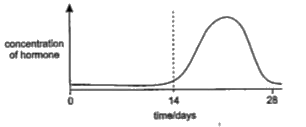
Which hormone is shown by the curve? View SolutionQuestion 94
At the start of the menstrual cycle, the lining of the uterus wall breaks down. As each follicle in the ovaries develops, the amount of oestrogen produced by the ovary increases. The oestrogen act on the uterus and cause its lining to become thicker and develop more blood vessels. These are changes that help an early embryo to implant. Two hormones, follicle-stimulating hormone (FSH) and luteinising hormone (LH) promote ovulation. Once the ovum has been released, the follicle that produced it develops into a solid body called the corpus luteum. This produces a hormone called progesterone, which affects the uterus lining in the same way as the oestrogens, making it grow thicker and produce more blood vessels. If the ovum is fertilised, the corpus luteum continues to release progesterone and so keeps the uterus in a state suitable for implantation. If the ovum is not fertilised, the corpus luteum stops producing progesterone. As a result, the thickened lining of the uterus breaks down and loses blood, which escapes through the cervix and vagina.
Two hormones, X and Y, are secreted by the ovaries. The graph shows the concentrations of these hormones in the blood during one complete menstrual cycle. What are hormones X and Y?
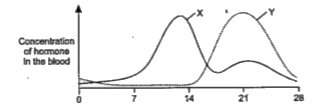 View Solution
View SolutionQuestion 95
At the start of the menstrual cycle, the lining of the uterus wall breaks down. As each follicle in the ovaries develops, the amount of oestrogen produced by the ovary increases. The oestrogen act on the uterus and cause its lining to become thicker and develop more blood vessels. These are changes that help an early embryo to implant. Two hormones, follicle-stimulating hormone (FSH) and luteinising hormone (LH) promote ovulation. Once the ovum has been released, the follicle that produced it develops into a solid body called the corpus luteum. This produces a hormone called progesterone, which affects the uterus lining in the same way as the oestrogens, making it grow thicker and produce more blood vessels. If the ovum is fertilised, the corpus luteum continues to release progesterone and so keeps the uterus in a state suitable for implantation. If the ovum is not fertilised, the corpus luteum stops producing progesterone. As a result, the thickened lining of the uterus breaks down and loses blood, which escapes through the cervix and vagina.
Assuming ovulation occurs on day 14, which event occurs at the time of ovulation? View Solution
All Exercises from SRIJAN BIOLOGY (ENGLISH) Class 12 BIOLOGY HUMAN REPRODUCTION
- ASSERTION AND REASON
- CHOOSE THE ODD ONE OUT OF THE FOLLOWING
- FIGURE BASED QUESTIONS
- FILL IN THE BLANKS
- ILLUSTRATIVE QUESTIONS
- MATCH THE FOLLOWING
- MULTIPLE CHOICE QUESTIONS
- SOURCE BASED QUESTIONS
- PRACTICE QUESTIONS (LONG ANSWER TYPE QUESTIONS)
- PRACTICE QUESTIONS (SHORT ANSWER TYPE-I QUESTIONS)
- PRACTICE QUESTIONS (SHORT ANSWER TYPE-II QUESTIONS)
- PRACTICE QUESTIONS (VERY SHORT ANSWER TYPE QUESTIONS)
- PREVIOUS YEARS. BOARD PAPER QUESTIONS (LONG ANSWER TYPE QUESTIONS)
- PREVIOUS YEARS. BOARD PAPER QUESTIONS (SHORT ANSWER TYPE-I QUESTIONS)
- PREVIOUS YEARS. BOARD PAPER QUESTIONS (SHORT ANSWER TYPE-II QUESTIONS)
- PREVIOUS YEARS. BOARD PAPER QUESTIONS (VERY SHORT ANSWER TYPE QUESTIONS)
- REVIEW QUESTIONS
- COMPETITION CORNER (OBJECTIVE TYPE QUESTIONS (ASSERTION AND REASON TYPE QUESTIONS))
- COMPETITION CORNER (OBJECTIVE TYPE QUESTIONS (MULTIPLE CHOICE QUESTIONS))


